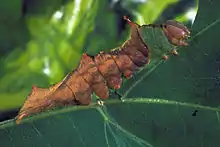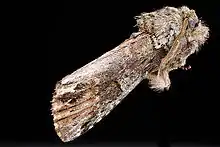Schizura unicornis
Schizura unicornis, the unicorn caterpillar moth, unicorn prominent or variegated prominent, is a moth of the family Notodontidae. The species was first described by James Edward Smith in 1797. It is found in all of North America, except the arctic north.[1][2]
| Schizura unicornis | |
|---|---|
 | |
| Larva | |
 | |
| Adult | |
| Scientific classification | |
| Kingdom: | |
| Phylum: | |
| Class: | |
| Order: | |
| Family: | |
| Genus: | |
| Species: | S. unicornis |
| Binomial name | |
| Schizura unicornis (J. E. Smith, 1797) | |
| Synonyms | |
| |
The wingspan is 24–35 mm.[3] The forewings are dark grey, variably shaded and marked with yellowish, rose and brown. The hindwings are dirty white, shaded with grey in males and dark grey in females. Adults are on wing from February to September in the south and from May to August in the north. There is one generation per year.
The larvae feed on Alnus, Malus, Populus tremuloides, Betula papyrifera, Ulmus, Crataegus, Carya and Salix species. They are brown, although the second and third thoracic segments are bright green. The head is mottled brown. Larvae can be found from May to October in the south and from June to September in the north. The species overwinters in the larval stage in a cocoon beneath leaf litter.
References
- Balaban, John & Jane (August 10, 2017). "Species Schizura unicornis - Unicorn Caterpillar Moth - Hodges#8007". BugGuide. Retrieved July 28, 2019.
- Savela, Markku (ed.). "Schizura unicornis (Smith, 1797)". Lepidoptera and Some Other Life Forms. Retrieved July 28, 2019.
- Robinson, E. & Anweiler, G. G. (September 2004). "Species Details Schizura unicornis". University of Alberta Museums. E.H. Strickland Entomological Museum. Retrieved November 11, 2020.